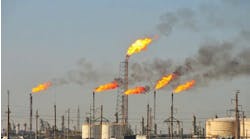This article was printed in CONTROL's May 2009 edition.
“Ask the Experts” is moderated by Béla Lipták, process control consultant and editor of the Instrument Engineer’s Handbook (IEH). Preparation of the next edition of Volume 3 “Process Software and Networks” is in progress. If you’re qualified to update an existing or to prepare a new chapter, please let me know. Similarly, if you would like to participate in answering the questions in this column or want to ask a question, write to me at: [email protected].
Q: I have a set of queries about vortex flowmeters. A) It is recommended that the Reynolds number (Re) be >20,000 (or >10,000 for certain pipe size), so that the Strouhal number is constant over measuring range. More than 10,000 means it's turbulent flow. Then why is upstream and downstream straight length run required for a vortex flowmeter? Is it for averaging the velocity, as vortex frequency is proportional to average velocity? B) For dual vortex flowmeter construction, how does the second vortex flowmeter avoid disturbance of the flow profile essentially generated by the first one? Why is no straight pipe run required for the second vortex flowmeter? I
presume the K-factor is adjusted for the second one.
Debasis Guha
[email protected]
A: I will leave the answering of your question to an expert colleague (below). What I would like to do here is to tell you about the discovery of the vortex phenomenon.
A child named Theodor von Kármán was fishing in one of the springs of Transylvania, a mountainous region in the kingdom of Hungary in the 1890s. He was fishing at his favorite spot. In front of him was a big rock in the water. The rock caused whirlpools (vortices) to form. As these vortices broke away and traveled downstream, Tódorka (his nickname) noticed that no matter if the water was running fast in the spring or barely moving in the summer, the distance between the vortices remained the same.
Because he had nothing better to do, he started counting the number of vortices formed per minute, and getting home, he reported to his father the number of fish caught and the number of vortices he counted in a minute. The other thing he did was that he kept thinking about those vortices. About the same time, a fellow in England was asking himself, why does water get turbulent? His name was Osborn Reynolds.
A few decades later, Tódorka managed to put two and two together, and came up with the Kármán theory of vortex streets, which allows us to calculate the air resistance that rockets have to overcome and made a major contribution to space travel. (By the way, I am thinking about combining fuel cells with electrolyzers.)
So, keep your eyes open and keep asking good questions.
Béla Lipták
[email protected]
A: With today's design of the bluff body (E+H, Emerson, Yokogawa, etc.), the Reynolds number must be at least in the range of 20,000 to get a Strouhal number that is almost independent of Re. Only with a constant Strouhal number can the vortex principle be used accurately (linearity). But a turbulent flow regime starts already at Re >3,000.
Adapted to our measuring principle, we specify a minimum Re number of 4,000. Below 4,000, the device can’t be used for reliable volume flow measurement. Roughly, this is the same for all other vortex suppliers (given by the vortex principle). So a vortex device always operates in the turbulent flow.
To answer your first question, we calibrate our vortex meters with ideal inlet runs, which results in a really proper flow profile. As soon as there are flow obstructions upstream, the flow profile is disturbed and looks different compared to the calibration, which causes different velocities around the bluff body, and finally different frequencies. The reason for the minimum specified inlet and outlet runs is to achieve identical flow profile to that at which the meter was calibrated. Instead of straight pipe runs, you can use flow conditioners to reduce the straight pipe run required upstream to the meter. Using a flow conditioner will also help to create the ideal flow profile as well.
In dual sensor designs, both sensors act as two completely independent units. They’re used for redundant measurements. These two sensors do not influence each other (see the design on the left below). This is an advantage compared to vortex designs using two sensors in series (see design on the right below). Our dual sensor design (on the left) is called the “Prowirl dualsens” design and has the same specification as the single sensor version.
Markus Neuhaus
[email protected]
Q : In one of our projects, we specified the thermowell and the flange to be made of 316SS material. The piping mating flange is of carbon steel. Is there any issue of galvanic corrosion? The client is insisting on insulation kits for flanges and bolts. The location is offshore and atmosphere is marine.
S. Krishnan
[email protected]
A: This is a typical thermowell installation in process industries. Insulation is called for personnel protection for higher temperatures or sweat prevent in cryogenic applications. Of late, a large refinery in south Louisiana is experiencing corrosion under insulation (CUI) in its storage facilities. Ambient air composition and sweating due to evaporation of light ends (C2 and C5) are causing added demand for capital expenditures to prevent corrosion and galvanic action. This project calls for special treatment of all exposed surfaces and a coating of epoxy base on all take-offs. Elaborate monitoring instrumentation is engineered. A special insulation jacket is installed on all flange take-offs, including 316 SS mating flanges to prevent possible chloride attacks. This line of thinking may be valid in off-shore platforms.
Ram G. Ramachandran
[email protected]
A: As a boat captain and a T-well manufacturer, I have to deal with galvanic corrosion in many ways. By the way the stuff on boats is much harder than thermowells.
Try to avoid dissimilar materials wherever possible. Use extra grounding where possible. Less electricity means less galvanic corrosion. Painting or polymer coating sometimes serves to hide corrosion, but is not in the best interests of a safe installation. If you’re going to coat a well with epoxy or polymer, use a clear variety. The coating will only delay the inevitable, but you’ll be able to see it when it happens with the clear coating.
Insulation might be recommended, but keep in mind that less heat keeps the galvanic process at a lower level. However, as the previous responder intimated, the insulation itself could lead to other problems. Something we call crevice corrosion occurs if water is not allowed to totally dry up quickly underneath the insulation or other gathering spots for moisture.
Actually, good preventive maintenance and occasional cleaning of these devices is well worth the time.
There is a new version of ASME PTC 19.3 (thermowell standard) that should be ready by this summer. We’ve been working on it for the last several years, and it will be of great use in helping engineers design better T-well installations. Look for it soon at your local standards store.
Frank L. Johnson
www.jms-se.com
[email protected]



